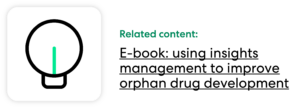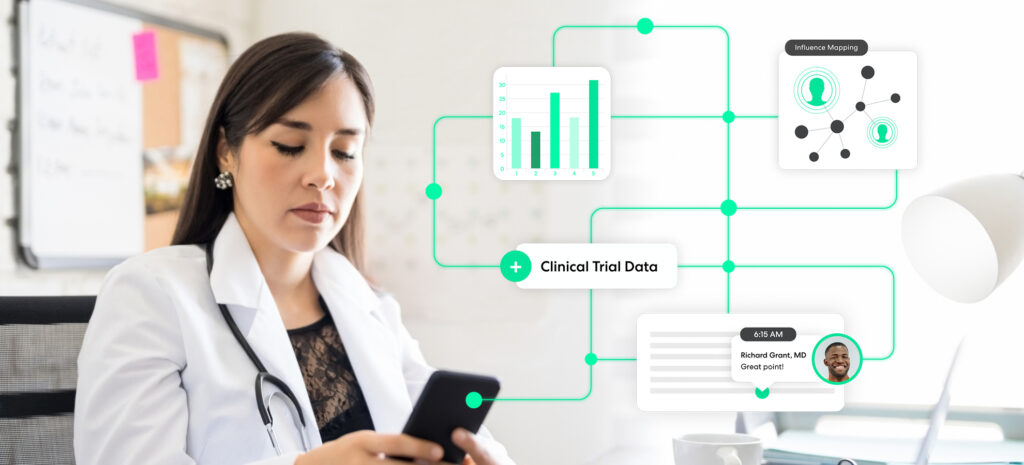Orphan drug development is complex and expensive. However, the future looks rosy for rare disorders and rare disease drug development. The rare disorders and orphan drug market is forecast to grow at twice the rate of that for non-orphan drugs, and orphan drugs will account for 20% of all prescription drug sales and nearly one-third of the global drug pipeline’s value by 2026.
Imbruvica, an orphan drug from AbbVie/Johnson & Johnson designed to treat chronic lymphocytic leukemia, is expected to be the biggest orphan drug in 2026, notching $13 billion in worldwide sales. Given this outlook, how can pharmaceutical companies successfully plan to develop rare disease drugs?
Factors to consider during the planning process
The typical process for developing an orphan drug closely mirrors that of any drug development plan. However, there are inflection points in the orphan products development process where companies should take extra steps to ensure they are on the right track. In general, here are some steps that pharma companies should follow when developing an orphan drug for clinical trial.
Identifying a rare disease
The first step in planning for drugs to treat rare conditions is identifying a rare disease with unmet medical needs. Clinical trial sponsors can do this in several ways, including analyzing data and working directly with patient advocacy groups to learn more. Technology offers new options for uncovering unmet needs to help out with rare disease drug development, including social media listening.
Social media offers access to unstructured data in casual conversations, which may reveal details of the patient and caregiver experience and scientific exchanges between HCPs and researchers. Monitoring social media for these conversations overcomes one of the primary challenges around developing an orphan drug: small patient populations scattered over a wide geographic area. Patients often gravitate to a single platform on social media, which can become a rich data source for trial sponsors.
Conducting research
After identifying an unmet need in rare diseases, pharmaceutical companies conduct extensive research to understand the disease mechanism, potential drug targets, and patient experience. Important questions to answer during orphan product development might include how the condition affects the quality of life and life expectancy, whether or not there are any current treatments for the disease, and how successful those treatments are.
This research might involve collaborations with academic institutions, government agencies, and patient advocacy groups. Large pharmaceutical companies can also look at small biopharmaceutical companies and start-ups to see if treatments are currently being developed. Such companies are often the target of acquisition, perhaps explaining why are pharmaceuticals in high demand.
Conducting clinical trials
As with any potential new treatment, pharmaceutical companies conduct clinical trials to test an orphan drug’s safety and efficacy. These trials typically involve three phases, each with increasing numbers of patients and more rigorous testing. Patient recruitment and enrollment are always critical but should be particularly rigorous for successful rare disease clinical trials due to the size of the patient pool and the likelihood of discontinuing participation.
Obtaining marketing approval
Following a successful trial, a sponsor can request the FDA to approve a drug for marketing in the US by submitting a new drug application (NDA). This application aims to provide enough information to allow FDA reviewers to reach key decisions about the drug’s safety and efficacy in its intended use, the labeling and packaging, and quality control standards.
The documentation should provide all the information about the drug, including what occured in clinical tests, the ingredients, results of animal studies, how the drug acts in the body, and how it is manufactured and packaged.
Launching the drug
Drug launch and all its elements – manufacturing the drug at a commercial scale, distributing it to physicians, ensuring payer coverage, and offering education and support to patients – is complicated for any drug. Orphan designation drugs, of course, come with some additional difficulties.
“Usually, when a large company introduces such a treatment, it is entering the relevant therapeutic area for the first time,” reports McKinsey. “It is therefore likely to lack both expertise in the disease and in-depth understanding of the health ecosystem and of patients’ experience of the disease.” By their nature, rare diseases will have few analogs from which to draw lessons.
Tips for developing a successful orphan drug
Oftentimes, big pharma companies will acquire an orphan drug from a small biotech company or startup at a late stage in development. While this saves the larger company the time and expense of early-stage R&D, it leaves less time to prepare for a successful launch. McKinsey says companies that are successful in launching orphan drugs tend to excel in four critical areas:
- Committing to work closely with the rare disease patient and caregiver community
- Using novel methods to find patients in need of treatment
- Unpacking a more granular approach to patient access
- Helping caregivers navigate the healthcare system
Planning for the development of these drugs is a complex and multi-step process that requires collaboration with several stakeholders, extensive research, and significant investment. However, this is true of any new drug – and successful orphan drugs can provide substantial and even life-saving benefits to patients with rare diseases.
How to measure success
Typically, the success of a drug intended to treat a disease or condition can be determined by whether or not it reaches its sales goals, physician and patient acceptance of the drug, and, ultimately, how well the treatment works for patients.
Traditional cost-effectiveness analysis may not work as well for orphan drugs, however. Assessing pharmaceuticals developed to treat rare diseases through a cost per quality-adjusted life year or QALY framework originated from the need to maximize public health given limited resources. But this approach is not well-aligned with orphan drugs, and a new model has been slow to emerge as the understanding of rare diseases increases.
Considerations for measuring the success of orphan drugs may take into account the severity of a rare disease – while not all rare diseases are severe, they tend to affect younger people and more significantly shorten lifespans – and therefore the impact on financial health over a lifetime, as well as the “value of hope.” Other aspects that can be difficult to measure include the often-high costs of orphan drugs and the long-term impact of successful treatment on things like disability payments, taxes, and other financial factors.
Instead, it may be helpful to evaluate the success of orphan drug incentives and guidelines like the Orphan Drug Act of 1983, which has resulted in the approval of more than 5,000 orphan drugs and seen increasing designations granted each decade. The top three therapeutic areas represented in the orphan drug designations were: oncology (37%), neurology (13%), and infectious diseases (9%).
Patient-centricity in orphan drug development
Although global regulatory bodies – including the FDA and the EMA – offer financial assistance and other incentives to encourage rare disease drug development, other approaches might also bear fruit. One such approach is increasing the incorporation of first-hand patient perspectives from the early stages of product development. According to Perspectives in Clinical Research:
“Patient-centricity in clinical trials is now being greatly emphasized in modern-day drug development. It has been implemented using many strategies, including incorporating electronic patient-report outcomes and engagement with patient advocacy groups. Conducting clinical trials related to orphan diseases are often challenging as very few patients are affected by rare disease across sparse geographical areas. In such circumstances, patients or related caregivers become very influential to the sponsors or regulatory authorities.”
In many cases, patients affected by a rare disease are the ultimate experts on their condition, and due to the isolation they can feel, are typically eager to share their stories. Regulatory agencies are making efforts to capitalize on this – for its part, the FDA created an online platform to capture patient stories and share the experience of FDA employees. Nonprofit organizations, such as the European Organisation for Rare Diseases and National Organization for Rare Disorders, promote patient advocacy for rare disease sufferers who might benefit from access to information sharing and networking.
Still, patient inclusion in rare disease drug development is nascent. How can teams ensure they incorporate input from patient groups from the early stages of drug development? In a real-world example, a medical affairs team wanted to understand patient perspectives about daily life with a chronic rare condition. The team used a virtual platform to let them engage with patients in Europe and the United States, soliciting feedback on education materials and a proposed study protocol. By engaging directly with patients, the team gained a much better understanding of how prospective trial participants would view the protocol and valuable insight on updating relevant patient-facing materials.
Insights management technology and orphan drugs
Technology can overcome many of the challenges unique to treating rare diseases. An insights management platform can manage nearly all aspects of the insight generation process during drug development, launch, orphan designation, and post-market monitoring. Insights management platforms unify several typically disparate processes that support the insights generation process, including identifying trial sites, finding rare disease experts, gathering input on protocol design and desired endpoints, and sharing directional information to drive business decisions.
By centralizing these typically disconnected activities in a single platform, trial sponsors can be more streamlined and focused on saving time and avoiding pitfalls during the trial design and execution process.
Learn more about how life science companies can engage patients to provide valuable information during the rare disease trial design process in our client’s success story.







